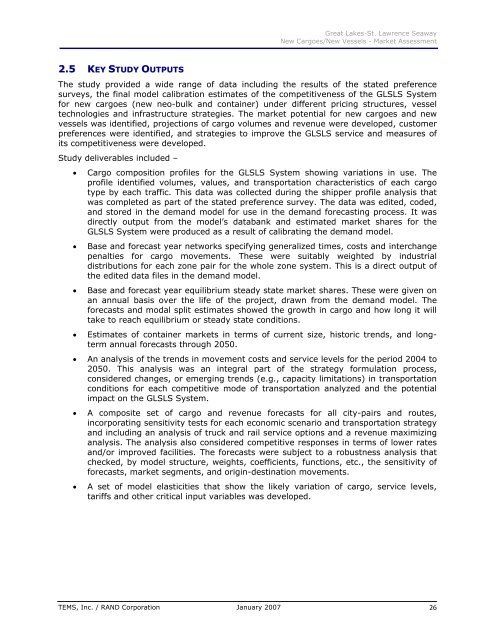great lakes-st. lawrence seaway new cargoes/new vessels market
great lakes-st. lawrence seaway new cargoes/new vessels market
great lakes-st. lawrence seaway new cargoes/new vessels market
- No tags were found...
You also want an ePaper? Increase the reach of your titles
YUMPU automatically turns print PDFs into web optimized ePapers that Google loves.
Great Lakes-St. Lawrence SeawayNew Cargoes/New Vessels - Market Assessment2.5 KEY STUDY OUTPUTSThe <strong>st</strong>udy provided a wide range of data including the results of the <strong>st</strong>ated preferencesurveys, the final model calibration e<strong>st</strong>imates of the competitiveness of the GLSLS Sy<strong>st</strong>emfor <strong>new</strong> <strong>cargoes</strong> (<strong>new</strong> neo-bulk and container) under different pricing <strong>st</strong>ructures, vesseltechnologies and infra<strong>st</strong>ructure <strong>st</strong>rategies. The <strong>market</strong> potential for <strong>new</strong> <strong>cargoes</strong> and <strong>new</strong><strong>vessels</strong> was identified, projections of cargo volumes and revenue were developed, cu<strong>st</strong>omerpreferences were identified, and <strong>st</strong>rategies to improve the GLSLS service and measures ofits competitiveness were developed.Study deliverables included –• Cargo composition profiles for the GLSLS Sy<strong>st</strong>em showing variations in use. Theprofile identified volumes, values, and transportation characteri<strong>st</strong>ics of each cargotype by each traffic. This data was collected during the shipper profile analysis thatwas completed as part of the <strong>st</strong>ated preference survey. The data was edited, coded,and <strong>st</strong>ored in the demand model for use in the demand foreca<strong>st</strong>ing process. It wasdirectly output from the model’s databank and e<strong>st</strong>imated <strong>market</strong> shares for theGLSLS Sy<strong>st</strong>em were produced as a result of calibrating the demand model.• Base and foreca<strong>st</strong> year networks specifying generalized times, co<strong>st</strong>s and interchangepenalties for cargo movements. These were suitably weighted by indu<strong>st</strong>rialdi<strong>st</strong>ributions for each zone pair for the whole zone sy<strong>st</strong>em. This is a direct output ofthe edited data files in the demand model.• Base and foreca<strong>st</strong> year equilibrium <strong>st</strong>eady <strong>st</strong>ate <strong>market</strong> shares. These were given onan annual basis over the life of the project, drawn from the demand model. Theforeca<strong>st</strong>s and modal split e<strong>st</strong>imates showed the growth in cargo and how long it willtake to reach equilibrium or <strong>st</strong>eady <strong>st</strong>ate conditions.• E<strong>st</strong>imates of container <strong>market</strong>s in terms of current size, hi<strong>st</strong>oric trends, and longtermannual foreca<strong>st</strong>s through 2050.• An analysis of the trends in movement co<strong>st</strong>s and service levels for the period 2004 to2050. This analysis was an integral part of the <strong>st</strong>rategy formulation process,considered changes, or emerging trends (e.g., capacity limitations) in transportationconditions for each competitive mode of transportation analyzed and the potentialimpact on the GLSLS Sy<strong>st</strong>em.• A composite set of cargo and revenue foreca<strong>st</strong>s for all city-pairs and routes,incorporating sensitivity te<strong>st</strong>s for each economic scenario and transportation <strong>st</strong>rategyand including an analysis of truck and rail service options and a revenue maximizinganalysis. The analysis also considered competitive responses in terms of lower ratesand/or improved facilities. The foreca<strong>st</strong>s were subject to a robu<strong>st</strong>ness analysis thatchecked, by model <strong>st</strong>ructure, weights, coefficients, functions, etc., the sensitivity offoreca<strong>st</strong>s, <strong>market</strong> segments, and origin-de<strong>st</strong>ination movements.• A set of model ela<strong>st</strong>icities that show the likely variation of cargo, service levels,tariffs and other critical input variables was developed.TEMS, Inc. / RAND Corporation January 2007 26
















